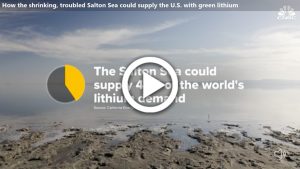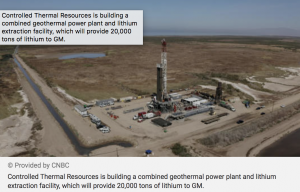Katie Brigham – Wednesday – CNBC
About 40 miles north of the California-Mexico border lies the shrinking, landlocked lake known as the Salton Sea. Though the lake was once the epicenter of a thriving resort community, water contamination and decades of drought have contributed to a collapse of its once-vibrant ecosystem and given rise to ghost towns.

But amid this environmental disaster, the California Energy Commission estimates that there’s enough lithium here to meet all of the United States’ projected future demand and 40% of the world’s demand. That’s big news for the booming electric-vehicle industry, as lithium is the common denominator across all types of EV batteries.
Traditionally, lithium extraction involves either open-pit mining or evaporation ponds, which work by pumping lithium-containing brine to the surface and waiting for the water to dry up. Both of these methods have huge land footprints, are often very water intensive and can create a lot of contamination and waste.
But at the Salton Sea, three companies are developing chemical processes to extract lithium in a much cleaner way, taking advantage of the Salton Sea’s rich geothermal resources. Near the lake, there are already 11 operating geothermal power plants, 10 of which are owned by Berkshire Hathaway’s renewable energy division, BHE Renewables.
“We are already pumping 50,000 gallons of brine per minute across all of our 10 geothermal facilities to the surface,” said Alicia Knapp, president and CEO of BHE Renewables, “and we’re using the steam from that brine to generate clean energy. So we’re really halfway there in that we’ve got the lithium right here in our hands.”
Two other companies, EnergySource and Controlled Thermal Resources, or CTR, are also developing joint geothermal-lithium facilities at the Salton Sea, and General Motors has already committed to source lithium from CTR.
This new industry could be a major economic boon to the region, where the majority Mexican-American community faces high rates of unemployment and poverty and suffers health impacts from the toxic dust that blows off the Salton Sea’s drying lake bed.
“We’re cautiously excited in regards to the Lithium Valley,” said Maria Nava-Froelich, the mayor pro tem of Calipatria, California, the city of about 6,000 where the geothermal power plants are located. “We see it as a game changer here for Imperial County.”
Nava-Froelich hopes the industry will bring much-needed jobs and development to the region, helping to revitalize communities that have seen an exodus of young people seeking opportunities elsewhere. And environmentalists hope that the influx of attention and money will hasten California’s efforts to restore the environment in and around the Salton Sea.
If ever there were a time to bet on domestic mineral projects, it might be now. At the end of March, President Joe Biden invoked the Defense Production Act to boost production of EV battery minerals such as lithium, nickel, cobalt, graphite and manganese.
But extracting lithium from geothermal brines has never been done before at scale, so it remains to be seen whether the electric-vehicle industry, the local community and/or the environment will actually benefit.
Lithium Valley
This isn’t the first time there’s been interest in lithium recovery at the Salton Sea. Hyped start-up Simbol Materials developed a demonstration plant, but the company ceased operations in 2015 after a failed acquisition attempt by Tesla and never developed a commercial-scale facility.
Since then, demand for lithium has shot up and, after falling sharply in 2018, prices are surging once again, incentivizing projects that might not have been economical before. If the current trio of companies can prove their technology works, they stand to make a lot of money from the hundreds of thousands of tons of lithium in the area.
“The Salton Sea field, fully developed, could well serve over 600,000 tons a year, when the world production is less than 400 [thousand] now,” said Rod Colwell, CEO of CTR.
Unlike Berkshire Hathaway and EnergySource, CTR doesn’t have any geothermal power plants in the region, so it’s building a joint geothermal and lithium recovery facility all at once. Currently, the company is constructing a demonstration plant and plans to open its first full-scale facility by the beginning of 2024, providing 20,000 tons of lithium to GM.
Colwell estimates that CTR’s first plant will cost just shy of $1 billion, a steeper price per ton of lithium than many traditional lithium recovery projects. But all three companies expect that price to drop as the technology develops further.

CTR is using ion-exchange technology, which it developed in partnership with Bay Area-based Lilac Solutions, to recover lithium. In this method, geothermal brine flows through tanks filled with ceramic beads, which absorb lithium from the brine. When the beads are saturated, the lithium is flushed out with hydrochloric acid, and lithium chloride remains. This is an intermediary product that CTR plans to refine on-site, yielding lithium carbonate or lithium hydroxide, a powder that’s ready to be processed and transformed into precursor chemicals and then manufactured into battery cells.
Berkshire Hathaway is also using ion-exchange technology, though the company hasn’t revealed as many specifics as CTR about how it will work.
EnergySource has developed technology known as Integrated Lithium Adsorption Desorption, or ILiAD, and it’s jumping straight into building a full-scale facility, which it expects to be operational by 2024.
“What we see in terms of production costs is that geothermal brine should be around the first quartile in terms of market competitiveness,” said Derek Benson, CEO of EnergySource.
Notably, all three companies plan to refine the lithium on-site, a process that normally takes place overseas. But the companies aren’t equipped to handle additional steps, such as chemical processing and battery cell manufacturing, which still primarily take place in Asia.
“The rest of the supply chain hopefully in the coming years will also be developed in the U.S.,” said Knapp, “so that we’re able to go straight from lithium and other minerals in the ground to batteries that we’re using to run our infrastructure.”
EV battery maker Italvolt recently announced plans to launch a new company, Statevolt, with the intent to build a $4 billion gigafactory in Imperial Valley that would produce enough lithium-ion batteries for 650,000 electric vehicles per year. Statevolt signed a letter of intent to source lithium and geothermal power from CTR, but did not respond to CNBC’s inquiry about whether it will do chemical processing on-site.
